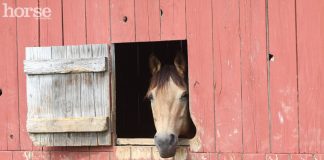 Over the past few decades, helmets have gone from a show-ring rarity to must-have safety gear available in a wide variety of colors and styles. Still, there are riders across all disciplines who choose not to wear a helmet because of tradition, pride, or plain indifference.
Over the past few decades, helmets have gone from a show-ring rarity to must-have safety gear available in a wide variety of colors and styles. Still, there are riders across all disciplines who choose not to wear a helmet because of tradition, pride, or plain indifference.
The campaign is a joint effort between a concerned rider and a prominent equine health company. Jeri Bryant is a marketing professional, dressage rider, and a fan of Olympian Courtney King-Dye. After the riding accident that left King-Dye in a coma, Bryant donated her t-shirt design to an eBay store set up to help assist with King-Dye’s rising medical expenses. The store is facilitated by SUCCEED equine digestive supplement. Together, Bryant and SUCCEED are spearheading the new campaign to educate more riders about helmet use.
According to Riders4Helmets.com:
- There is little difference in risk of head injury between western and English riders.
- 75-80% of equestrian-related head injuries occur while riding. The remaining occur when a person is on the ground working around horses.
- 15% of horse-related emergency room visits were due to head injuries.
- Head injuries are the most common reason for horse-related hospital admissions
- Head injuries are the number one horse-related cause of death, accounting for 60% of deaths resulting from equestrian accidents.
There are two primary types of head injuries.
Concussions are defined as “injury to the brain caused by a hard blow or violent shaking within the skull, causing a sudden and temporary impairment of brain function.” Symptoms can range from almost undetectable to very severe and include dizziness, blurry vision, headache, amnesia and nausea. These symptoms are often shrugged off by riders and other athletes and go undiagnosed and untreated. However, repeated concussions can cause permanent brain damage. Research published in the Journal of Athletic Training suggests that girls may be more susceptible to concussions than boys.
The second type of head injury is coma. This is defined as “a state of deep and often prolonged unconsciousness; usually the result of disease or injury.” Coma patients may be completely comatose, or they may be able to respond to some stimuli. A coma can last for days or weeks, and in rare cases can last years. The majority of coma patients do recover, but it is a gradual process. Patients typically take time to recover memories and must relearn how to do simple tasks such as walking or feeding themselves.
Modern helmets greatly reduce the risk of head injury by cushioning the landing of a fall with a layer of crushable foam. That foam slows the stopping time of a rider’s head as it hits a surface. Conversely, a bare head will come to an abrupt stop when it meets a hard surface, which causes the rider’s brain to literally crash into the inside of the skull. This secondary impact of the brain into the skull is actually where brain injuries often occur. This is why old-fashioned hunt caps, which are typically an unlined hard shell, will not protect against most damaging injuries. This is also why helmets must be replaced after a fall or other impact. The foam does not rebound after being crushed and will no longer provide reliable protection.
For more on the campaign, visit www.riders4helmets.com






I always wear a helmet and I don’t understand people who don’t. It is just stupid. You never know what can happen on a 1000lb animal of prey.
I hope it becomes mandatory to wear helmets. We have to wear seatbelts, don’t we?
Riders need to wear helmets whenever we work with a horse. I’m delighted to see that more riders are embracing the new USDF rules about helmets. I have had some close calls while riding and even hand-walking my horse. But I can write this comment because I had a helmet on at those times. Believe me, a “bad-hair day” or “helmet hair” isn’t nearly as devastating as not being able to ride or be with a horse, at all!